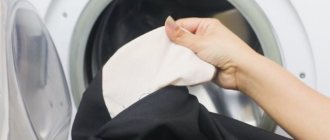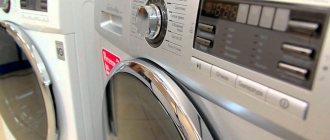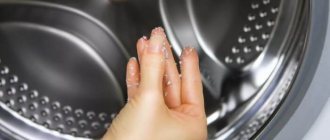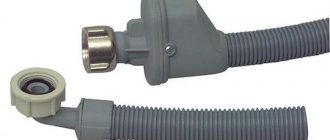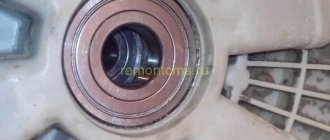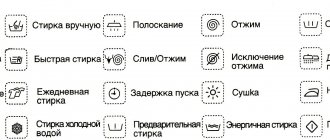That's what happened! You are the happy owner of an eco-friendly smart washing machine. Samsung engineers have proposed a unique Eco drum cleaning technology. How to use it and what is it? Definitely, there is no longer any need to purchase lemon juice, bleach and other products to clean the drum. There is no need to run the device idle to clean it, from now on it will worry about its own cleanliness.
Regular cleaning is excellent prevention
Without the slightest doubt, a washing machine is considered an essential component of a furnished home.
It’s hard to imagine that anyone now could do without this “tireless home assistant.” Diligently dealing with our problems, the machine interacts with detergents, industrial and edible oils, and poorly filtered tap water. In terms of dirt deposition, the most vulnerable component of the unit is the drum, which is in direct contact with both the laundry being washed and with powders, conditioners and similar liquid products. Unfortunately, most housewives judge the contamination of the drum only by the appearance of an unpleasant odor, reminiscent of the “aromas” of a swamp.
Image gallery Photos from Odor is a consequence of the spread of microorganisms, the nutrient medium for which is organic contaminants, fat, and fabric fibers remaining after washing in the machine.
Much more dangerous for household equipment is the mineral deposit that forms during a washing session.
Calcium and magnesium salts growing on the surface of the drum interfere with the normal operation of the washing machine, increase the load, and gradually disable it.
Scale on the walls of the drum, working elements and components of the washing machine leads to the replacement of expensive components, sometimes to the need to purchase new equipment
Unpleasant smell from the washing machine tank
Mineral deposits on the tank walls
Insoluble deposits on the drum walls
Forced drum replacement
In fact, smell is not the most insidious enemy of washing equipment, although it should be given the utmost attention. It signals the appearance of putrefactive bacteria and mold fungi that harm the things processed by the machine, and not the working units and parts
Note that the atmosphere formed by microorganisms creates an extremely serious threat to the health of the owners of the premises with a washing machine. This means that it should be fought with a zeal worthy of its significance.
The danger to the functional parts of washing units lies in mineral deposits. This scale settles both on the surface of the drum accessible to users and on its back side. While the first component can be easily dealt with using folk remedies, eliminating the second often requires disassembling the machine and removing the tank and drum.
Regular maintenance of the washing machine, cleaning its components from scale, grease deposits and other contaminants will significantly increase the period of flawless operation without breakdowns or repairs.
The list of problems caused by scale includes:
- Disruption of water circulation during washing. The perforation of the drum clogged with sediment prevents the normal flow and outflow of water.
- Failed drain pump. “Pushing” water through a filter clogged with scale, the pump experiences almost cosmic loads and eventually breaks down.
- Slow down water heating. The thermal conductivity of the mineral deposit is noticeably lower than that of the metal parts of the machine without it. Mineral deposits as a result affect the quality of washing.
- Increased energy consumption. Units and systems operating under load consume more electricity.
- Accelerated wear of the tank and drum pulley. Mineral sediment contributes to abrasion of contacting and closely located elements.
Scale appears due to the supply of water to the machine with an impressive content of magnesium and calcium salts. Installing main filters will help eliminate or significantly reduce the flow. However, they will not be able to completely eliminate the likelihood of sediment formation. Those. You will still have to clean the unit, although much less frequently.
Almost all washing machine drums are not afraid of rust, because... materials resistant to it are used in production. The exception is cheap devices of dubious manufacture.
Rust, of course, is a dangerous factor for washing machines, but it is mainly the body that suffers from it. Drums are made from materials adapted to work in water with household chemicals. Although this does not mean that cheap units are not susceptible to rust.
In order to eliminate all possible preconditions for reducing the service life of the machine and conditions that threaten the health of the owners, regular, competent care is necessary. The peculiarities of its implementation should be understood.
Specifications, Environmental Protection, Declaration of Conformity
Page 49
- Image
- Text
Russian — 49
TECHNICAL SPECIFICATIONS
ACTERIS
TIKS
Specifications
Environment protection
• This device is made of recyclable materials. If you decide to throw away
device, follow local regulations for household waste disposal. Cut the power cord so that the device cannot be connected to a power source. Remove the door to prevent pets or small children from becoming trapped in the unit.
• Do not exceed the amount of detergent recommended in the manufacturer's instructions. • Use stain removers and bleaches before starting a wash cycle only if absolutely necessary. • Save water and energy by loading the machine completely when washing (accurate load weight
depends on the washing program used).
Statement of Compliance
This device complies with European safety requirements, EC Directive 93/68 and EN 60335.
Untitled-5 49
2014-03-20 �� 12:15:37
Cleaning the inlet hose filter
You are almost certainly faced with a clogged problem if your washing machine is slow to fill. The filter of the device captures debris from the water supply, prevents it from entering the machine and protects the internal parts. It is possible that it is clogged with mineral deposits and tiny particles of debris.
Contamination occurs most often after repairs to the water supply system (both in an apartment and in a public network). Any work on water supply lines increases sediment in the pipes, and, as a result, on the filters. And it’s worse if the hose is clogged. This component of the washing machine is more difficult to clean.
Cleaning the filter is not difficult. The only thing you need to be careful when you remove the filter. Don't yank it. Gently squeeze and twist as you pull towards yourself. If it bends a little, return it to its original shape by straightening it with your fingers.
Tip: If there are too many lime deposits on the filter, it is unlikely that you will be able to wash it. Buy a new one: they are inexpensive and sold at plumbing stores.
What you need to prepare before cleaning the filter:
- screwdriver 4 in 1;
- needle nose pliers;
- utilitarian knife.
The procedure is as follows:
1. Turn off the water, disconnect the hoses.
2. Use a pair of pliers to remove the filter. 3. Remove sand and debris from it. Pry out the stuck particles with a knife. 4. Rinse under water or blow with a hairdryer. 5. Put the filter in place by pressing on the rim with a screwdriver. 6. With hoses and water, do everything in reverse order: connect the hoses, turn on the water, checking for leaks.
Garbage filter
Page 44
- Image
- Text
Russian — 44
Garbage filter
It is recommended to clean the debris filter 5-6 times a year to prevent it from clogging. A clogged debris filter may reduce the effectiveness of the bubbles. 1. Turn off the washing machine and unplug the power cord from the outlet. 2. Drain the remaining water in the drum following the instructions in section
“Emergency drain” on page 42.
3. Open the filter cover using a coin or lock key. 4. Turn the debris filter plug to the left and drain the remaining water. 5. Remove the debris filter.
6. Clean the debris filter using a soft bristle brush.
Make sure the drain pump blades located inside the debris filter are not dirty.
7. Reinstall the debris filter and turn the filter plug
to the right.
• To open the filter protection plug, press down on it and
turn counterclockwise. The plug opens easily thanks to the spring installed inside.
• To close the filter protection cap, turn it
clockwise. When turning the plug, the spring will make a grinding sound, which is normal.
• If the debris filter is clogged, the display will show error code “5E”.
CAUTION • After cleaning the filter, make sure the filter plug is closed properly. Otherwise
this may cause water leakage.
• After cleaning the filter, make sure it is installed properly. Otherwise it may
cause the machine to malfunction or cause water leakage.
Untitled-5 44
2014-03-20 �� 12:15:37
How to clean the washing machine from dirt inside
Reasons for the appearance of dirt and odor in the machine:
- high iron content in water;
- Frequent use of the delicate wash cycle. A temperature value of 40°C does not completely remove residual grease and dirt from clothing. The washed dirt flows from the drum into the drain hose and seal. Over time, the dirt decomposes and an unpleasant odor appears;
- Laundry detergents (bleaches, powders, conditioners) do not completely dissolve in water during washing. They fall under the rubber.
How to clean the heating element of a washing machine from scale
Several ways to clean the heating element from plaque:
- citric acid. Cleaning with citric acid technology is no different from the procedure we described above. You need to pour acid into the powder compartment and set the machine to work in any mode with high temperature. The acid, when heated, destroys plaque and limestone, cleans the drum and heating element from scale;
- manual cleaning of the heating element. In the case of cleaning with chemicals, fragments of limescale may remain inside, so if the situation requires high-quality cleaning, it is better to do this with the help of a specialist by disassembling the front panel.
Step-by-step instructions for cleaning the heating element.
| Illustration | Description of action |
| Remove the back cover of the washing machine. | |
| Disconnect the wires, the sensor and remove the heating element itself. Scale and accumulated dirt can hinder the process. In this case, pry up the flange using a flat-head screwdriver. Movements should be as smooth as possible so as not to damage the lining and tank. | |
| This is how a heating element can look unsightly after several years of operation. Rinse the heating element with a tight stream of warm water, this will remove fresh deposits and dirt. | |
| To completely get rid of plaque, you will need a concentrated solution. Take a plastic bottle with the neck cut off and add 4 tablespoons of citric acid. | |
| As they say, “feel the difference.” | |
| We place the clean heating element back, doing all the steps in reverse order. |
How to clean a washing machine drum
If the washing machine does not have an automatic drum cleaning mode, manual cleaning will be required. Let's look at how to clean the drum:
- Pour 2-3 packs of citric acid into the powder compartment.
- You can put a few clean kitchen towels in the machine so as not to force the device to work for nothing.
- Set the synthetic mode and temperature to 90°C. Run the wash for 2 hours.
- Turn on rinse mode.
If the smell remains, the fungus has spread to the filter and needs to be cleaned.
Cleaning the glass and rubber seal of the washing machine door
To clean your washing machine, the following steps are required:
- Place a pinch of copper sulfate in a glass of water and stir until completely dissolved.
- Leave for 3 hours to ensure that no substances that corrode the gum remain.
- Using a sponge or toothbrush, apply the product to the gum.
- Treat parts and hard-to-reach places, leave for a day.
- The next day, prepare a soap solution.
- Use a sponge to remove the remaining crust and the product itself.
The door can be wiped with a sponge or towel; if necessary, you can use a soap solution instead of water.
How to wash detergent and conditioner trays in a washing machine
Due to stagnant water, mold and mildew form in them. The compartments need to be washed every 5-7 uses of the washing machine. Remove the tray and use a sponge or brush to wash it with bath cleaner.
Cleaning the drain pump and filter of the washing machine inlet hose
If you do not pay proper attention to the drain pump filter, the machine will stop draining water. There is an easy way to clean it. Aids needed:
- the oven tray will be used as a tray;
- cloth;
- flat screwdriver.
Actions:
- Open access to the pump filter at the bottom of the machine body.
- If access to the filter is blocked by a panel, use a screwdriver.
- Before opening the filter, place a cloth on the floor and place a tray to prevent water from ending up on the floor.
- Unscrew the lid.
- Take out all the trash.
To clean the inlet hose filter, follow these steps:
- Before starting work, turn off the cold water.
- Turn the back of the machine around so that the inlet hose is visible.
- Unscrew the nuts and remove the filter using pliers.
- Clean it with a toothbrush.
- Insert the filter back and tighten the hose.
- Open the water.
Why is a “dirty” drum dangerous?
Contaminants that enter the machine are not completely washed out during the washing process; the resulting mold and mildew can, in addition to a relatively “harmless” unpleasant odor, cause allergies or other diseases dangerous to humans. The accumulated dirt settles on the laundry, which is washed again, and not only white clothes suffer from this.
Warranty terms The warranty does not apply to...
- Image
- Text
29
terms of guarantee
U
The warranty does not apply to:
• Visits from the repair service to teach how to use the purchase. • If any voltage other than the recommended one is used
for a car.
• If the device is damaged as a result of an accident or natural disaster
disasters.
• If the device is damaged due to improper use, do not
instructions provided for by the rules.
• The device is used before reading the instructions or parts,
included in the kit are replaceable.
• If the appliance is damaged due to pets or rats, cockroaches or
etc.
• The usual noises and vibrations for the device appear: the sound of merging
water, drying sound, warning signals.
• The warranty does not include installation of the device or connection of hoses. • The warranty will not include maintenance recommended in the instructions. • The supplier is not obligated to remove foreign objects from the machine, including
pump, filters, nails, wires, screws, etc.
• The supplier does not undertake to replace plugs or change cables in the home. • The supplier does not undertake to correct the consequences of unqualified
repair.
• Damage to personal property, directly or indirectly caused by
was caused by a possible malfunction of the device.
• The warranty does not cover cases where the product is used in commercial
purposes. (For example: public places such as toilet, hotel, training center, rental house)
Disposal of old equipment
1. The symbol on the device that shows a crossed line
wheelie bin means that the product is subject to Directive 2002/96/EC.
2. Electrical and electronic devices must
not be disposed of with household waste, but through special places designated by government or local authorities.
3. Proper disposal of old equipment will help
prevent potentially harmful effects on the environment and human health.
4. For more details about the old
equipment, contact your city administration, recycling service or the store where you purchased the product.
Comments
Highlight → I found instructions for my home here! #manualza
Click →
From the instructions for using a gas mask: - Pull until the point is in front of the eye!
Manualza!manualza.ru
Still not with us?
https://youtube.com/watch?v=HZxOxnVgPCQ
https://youtube.com/watch?v=SSlaqRaItko
Information codes
Page 48
- Image
- Text
Russian — 48
Information codes
If there is a malfunction in the washing machine, an information code is displayed on the display. Review the information in the table below and try the suggested solution to the problem.
Malfunction
Remedy
DE
• Make sure the door is tightly closed. • Make sure that laundry is not caught in the door.
4E
• Make sure the water supply valve is open. • Make sure the machine is running with sufficient water pressure. • Clean the strainer as it may be clogged.
5E
• Clean the debris filter as it may be clogged. • Make sure that the drain hose is straight along its entire length. • Clean the strainer as it may be clogged.
UE
• Laundry is not loaded evenly. Redistribute laundry.
CE/3E/UC
• Cannot be corrected by the user. Contact a Samsung service center.
If any code continues to appear on the display, contact a Samsung service center.
Untitled-5 48
2014-03-20 �� 12:15:37
What causes the washing machine drum to become dirty?
Various factors can contribute to dirt getting into the outside of the drum. Let's take a closer look at the most common ones.
Sand and other hard dust from clothes
We immerse dirty laundry in the washing machine drum to make it clean. But few people think about the fact that there is sand, hard dust or other particles on the clothes at the time of washing that are not washed off with water and are deposited on the drum of the washing device over time.
In addition, many of us forget to check our pockets for small debris, for example, paper clips, coins, pins, pieces of wire, etc. This applies to work clothes in which a person spends a lot of time at work.
Also, dirty clothes may contain traces of grease or machine oil, which, in turn, gets on the walls of the device, creating favorable conditions for the growth of bacteria or the formation of mold.
To avoid negative consequences and early drum failure, always check clothing pockets before loading, and shake off any debris or solid dust from laundry before placing it in the washing machine. In addition, it will be useful to use a special washing bag, which will prevent threads and small pieces of fabric from getting into the washing drum.
Scale
Regardless of the quality of the chemicals used for washing, scale will form on the walls over time. In accessible places it is not difficult to remove, but, as a rule, there is a chance of scale penetrating into other parts of the device and heating elements.
The main reason for its formation is the salts contained in the water. It is recommended to add special water softening agents to the powder before each start. According to experts, chemicals harm the washing machine and recommend the use of high-quality filters that purify water.
Plaque formation
Often, due to the use of low-quality detergents, chemicals accumulate on the walls of the machine. When washing and rinsing clothes, water only partially washes them off the surface.
How to start the drum cleaning function
The Eco function involves minimal energy consumption, as well as environmental friendliness when cleaning mechanisms. The need for it will be indicated by the icon on the machine’s display in the form of a drum with an asterisk or another icon. This does not mean that the machine is damaged, but it does indicate the need for cleaning.
It does not require any additional investments, you just need to turn on the machine and set the function, the cleaning temperature is about 70 degrees.
If you don’t have the time or opportunity to do the cleaning right away, you can postpone it, but you shouldn’t delay it.
How is scale formed and why is it dangerous?
Another inevitable problem when operating any device that comes into contact with water is the formation of scale. If you have a boiler with an open or “wet” heating element, then you probably know this phenomenon.
Scale is hard deposits that form on the surfaces of elements that are in direct contact with water and provide its heating. There are several reasons for the formation of such deposits:
- The most basic is the very poor quality of water, which contains many different impurities and components. In some regions or areas the water may be softer, in others it may be too hard. The water contains magnesium and calcium salts, which are the most harmful to the heating element and the washing machine tank. When water is heated, the salts of these minerals precipitate and form solid deposits;
- In addition to impurities in the water itself, various chemical additives in washing powders also have a detrimental effect;
- Also, scale forms very quickly when the machine is regularly used in the “intensive wash” mode.
There are two ways to get rid of scale. And it is best to use them in combination. But first of all, you need to evaluate how advisable it is to do this right now. To do this, you need to try to consider the state of the heating element through the holes of the drum. To do this, you need to shine light into the holes and rotate the drum. You will understand in the process how best to do this quickly. If characteristic deposits are visible on the surface, perform two types of cleaning in sequence:
- Mechanical. It is a very effective way. But to do this, you will need to thoroughly study the structure of your device and be able to disassemble it without dire consequences. After you get to the heating element and more clearly appreciate the full scale of the tragedy, you will need to remove the hard coating. It is highly not recommended to use knives, screwdrivers, files and other improvised tools for these purposes that can leave scratches on the surface. It is better to use a sponge with a hard layer, fine-grained sandpaper;
- After this, to remove any remaining scale, soak the heating element in a solution of vinegar or citric acid for several hours, then thoroughly brush with a toothbrush and rinse with clean water. Also, with the help of these two products, you can clean the machine without disassembling it, but more on that a little later. I would also like to clarify exactly what is dangerous about excessive scale accumulation on the heating element:
- The level of heat transfer from the tubes, which are called heating elements, is noticeably reduced due to the build-up of plaque on their surface. This causes the water to heat up more slowly;
- As a result, to achieve the set temperature, the machine needs to work much longer, which naturally entails increased energy consumption;
- The large load that falls on the heating element under such operating conditions will lead to its rapid breakdown and the need for replacement;
- And as we have already found out, scale formation can cause an unpleasant odor.
- An excellent method of preventing scale formation is to install a magnetic filter. This small device is attached to the water supply hose and creates a constant magnetic field. When the machine is filled with water, passing through the formed field, it changes its structure. As a result, impurities are destroyed and do not settle on internal surfaces. The cost of such a device is quite high, however, its service life reaches 50 years, which fully justifies the costs.
Cleaning, Cleaning the external surface of the washing machine, Strainer
Page 43
- Image
- Text
Russian — 43
OBS
TINING
Cleaning
Cleaning the outside of the washing machine
Use a soft cloth and non-abrasive detergent. Do not spray water on the washing machine.
Strainer
Clean the water supply hose strainer once or twice a year. 1. Turn off the washing machine and unplug the power cord from the outlet. 2. Close the water tap. 3. Disconnect the water supply hose from the back of the washing machine.
Cover the hose with a cloth to prevent water from escaping.
4. Using pliers, remove the strainer from the inlet
valve
5. Place the strainer in water along with the threaded connection. 6. Dry the filter completely in the shade. 7. Install the strainer into the water supply hose and install the hose
supplying water to the site.
8. Open the water tap.
If the strainer is clogged, the display will show error code “4E”.
Untitled-5 43
2014-03-20 �� 12:15:37
How to clean a washing machine
There are several ways to clean a washing machine at home. Options for cleaning your washing machine:
- soda;
- citric acid;
- citric acid with the addition of white;
- acetic acid;
- bleaches;
- copper sulfate;
- chemical means.
Household chemicals for washing machines to remove dirt and scale
Here is an overview of the best cleaning products for washing machines. For convenience, we have compiled the most important information in a table.
Folk remedies for cleaning a washing machine
Among folk remedies for cleaning washing machines, citric acid, copper sulfate, and vinegar are very popular. These simple remedies, which are found in every home, not only rid the machine of scale, but also eliminate mold, mildew and unpleasant odors. As an example, here are step-by-step instructions on how to descale a washing machine with vinegar. It is widely known that acetic acid easily removes plaque and removes it from the elements of the device. If you carry out such prevention regularly, the risk of your washing machine becoming clogged with lime will be minimized.
| Illustration | Description of action |
| We check the drum and, if necessary, remove things from it. | |
| Take a glass of 9% vinegar and pour it into the washing machine tray intended for loading powder. | |
| We set the highest temperature and the longest wash cycle. We start the washing process. | |
| After the vinegar is mixed with water and the solution is heated, pause the machine and wait for at least an hour. Then we start the wash again and cleaning resumes. You must wait until the end of the cycle. | |
| After completing the program, be sure to clean the drain filter. Small pieces of scale may accumulate on it. | |
| Next, dilute a tablespoon of the same vinegar in half a liter of water. And we wipe the accessible parts of the spiral machine with the solution: the drum, rubber parts, the body itself, as well as the removable filter. | |
| Cleaning ends by starting the washing machine for one more cycle. But this time you don’t need to add anything, no reagents, no cleaning agents, we choose a short washing cycle. It will be enough to completely clean the device from residual detergent components and scale residues. | |
| We wipe all parts of the machine with a dry cloth. And don't forget about the powder tray. We leave all parts of the machine as open as possible, allowing the machine to get rid of the acrid smell of vinegar. |
Autodispenser
Page 45
- Image
- Text
Russian — 45
OBS
TINING
Autodispenser
To ensure proper operation of the machine, regular cleaning of the autodispenser is required. 1. Remove the autodispenser from the washing machine.
2. Wipe the installation area of the autodispenser with a dry cloth.
3. Remove two handles and two plugs from the bottom from the autodispenser and
Rinse it with water to clean the inside. Do not shake the autodispenser, as water may splash out of its holes.
4. Reinstall the handles and caps. 5. Reinstall the autodispenser.
Untitled-5 45
2014-03-20 �� 12:15:37
No image, show text version
ECO on Samsung machines
According to statistics, in Russia Samsung machines occupy one of the leading positions in terms of use among ordinary users. Therefore, let’s look at what Eco modes are on one of the models called Samsung WF1602YQR. The savings program for this SM is listed as “Intensive IVF” and has the following features:
- The drum can only be loaded 2/3 full in this mode. This is not entirely convenient, because if your machine has a load of 6 kg, then you will only have to wash 4.
- There is no pre-wash option.
- On average, washing takes 4 hours, of which 3 hours and 40 minutes are the main wash, and another 20 minutes are for activating additional functions.
- Washing mode – 40 degrees.
- Additional options include the Eco Bubble, Easy Ironing and Delay functions, which can be activated if desired.
The above means that if you have enough time, you can safely turn on this mode. But if you need to wash things quickly, you will have to give up saving. And yes, don’t forget that Eco is about saving; the regime has nothing to do with the environment. Basically, with the help of this program you can save electricity, since the problem of high electricity tariffs is acute not only in Russia, but also in the West. That is why Western engineers came up with such a special regime.
Share your opinion - leave a comment
Restoring the machine after freezing, Storing the washing machine
Page 46
- Image
- Text
Russian — 46
Restoring machine operation after freezing
At temperatures below 0°C the washing machine may freeze. 1. Turn off the washing machine and unplug the power cord from the outlet. 2. Run warm water over the faucet to loosen the water supply hose. 3. Disconnect the water supply hose and immerse it in warm water. 4. Pour warm water into the drum and leave it for 10 minutes. 5. Reconnect the water supply hose to the faucet.
If you are unable to restore normal operation of the washing machine, repeat the steps described above as many times as necessary.
Storing the washing machine
Avoid leaving your washing machine unused for long periods of time. However, if necessary, drain all water from the machine and unplug the power cord. 1. From the Home screen, touch Mode > Cotton with Quick Wash option. 2. Remove laundry from the drum and press Start. 3. When the cycle is complete, close the water tap and disconnect the water supply hose. 4. Turn off the washing machine and unplug the power cord from the outlet. 5. Open the door to allow air circulation in the drum.
Untitled-5 46
2014-03-20 �� 12:15:37
Industrial cleaning products
Among them there are universal ones that clean washing machines from dirt, scale, etc. There are also highly specialized ones.
- "Dr. Beckmann." Washing machine cleaning product from a German manufacturer. In addition to the fact that it gets rid of scale, dirt and other various deposits, specialized additives protect metal parts from premature wear.
- "Magic Power" Also from a German company. Effectively helps against scale. The composition contains acid, so when using it you must strictly follow the instructions.
- "Topper." Another German, this time the manufacturer is German, widely known in our country. Removes not only scale from the machine, but also dirt and salt deposits.
- "Kristall-fix". Russia. The product contains citric acid and a water-soluble polymer. It begins to act effectively even at a water temperature of 60 degrees.
- "Doctor TEN." Russia. Quickly removes scale from any household appliances, including washing machines.
- "Sandokkaebi." Korea. A relatively cheap anti-scale product with average effectiveness.
- "Antikalk for Washing Machines from Sano." Israel. Descaling gel.
If you want to save money, there are ways to clean your washing machine using simple, folk remedies.
Emergency drain
Page 42
- Image
- Text
Russian — 42
Emergency drain
In the event of a power failure, drain all water from the drum before removing the laundry. 1. Unplug the washing machine's power cord from the outlet. 2. Gently press the top of the filter cover to open it.
3. Carefully pull out the emergency drain tube.
4. Hold the end of the drain tube and open its cap.
5. Drain the water into a container. 6. Close the drain tube cap and push it back into place. 7. Close the filter cover.
Untitled-5 42
2014-03-20 �� 12:15:37
Prevention measures
Ordinary vinegar will help reduce water hardness and slow down the process of scale formation on heating element tubes. It is enough to pour one glass of 9% table vinegar into the powder compartment and into the drum of the washing machine and start the washing mode at +60 ℃. Instead, you can use soda, dividing one pack of powder between the tray and the drum. Preventative cleaning of the unit can be carried out once a month.
Vinegar is an excellent means of preventing scale formation in a washing machine.
Vinegar can also be used when washing clothes by adding it to the fabric softener compartment. The product will soften not only water, but also fabrics, and also remove the smell of powder.
What else can you do so that you don’t have to think about how to descale your washing machine? Prevention measures are as follows:
- use only high-quality powder;
- Avoid using liquid detergents and rinse aids;
- do not overuse washing at high temperatures;
- use specialized products to reduce water hardness.
Calgon water softener will help prevent scale formation in your washing machine
Use our tips and you will insure your equipment against breakdowns due to scale formation!
How do you know when it's time to clean the drum in Samsung washing machines?
How will this happen? Let’s say that after a certain number of washes there is a need to clean the drum. The display board will immediately inform the owners by the appearance of a “drum” icon and an asterisk symbol on it. At the same time, the “Eco cleaning” warning light will light up.
It may happen, it will happen at the wrong time, you don’t have time to deal with it now. Nothing bad will happen. This is not a symptom of a global breakdown of the machine, but an indicator that the drum is dirty and needs to be cleaned. The indicators will turn off after a while and will notify you again about the need for cleaning again after two washes.
Pros and cons of cleaning with citric acid
The properties of citric acid are determined by its chemical structure. This substance was not invented specifically for cleaning washing machines, so its effect on equipment parts has both positive and negative sides.
Positive aspects of the method
Without cleaning the scale in the SM, you can expect, at a minimum, burnout and the need to replace the heating element. Therefore, there is no need to delay the cleaning procedure. The method for removing deposits should allow anyone without experience to carry out the procedure.
If you decide to regularly clean your SM with citric acid, you can buy a large volume of it at once. It will be cheaper and less troublesome
The use of citric acid to eliminate accumulated insoluble salts meets this requirement due to a number of advantages:
- Availability and low cost. Citric acid in the required quantity can be bought in any store for several tens of rubles.
- Simplicity. Even an untrained person can carry out the cleaning procedure.
- Efficiency. 100 g of citric acid will dissolve up to 80 g of scale.
- Safety. Both citric acid and calcium citrate formed after dissolving scale are harmless to health.
These positive aspects of LC make it the drug of choice in the fight against scale. There is no point in buying expensive special products for cleaning SM if they provide a similar effect.
Citric acid is used both in caring for the internal and external parts of the washing machine. The advantage of this folk remedy is that using lemon juice can effectively clean surfaces that are inaccessible to the user.
Confirmation of the effectiveness of removing accumulations with citric acid is demonstrated in the video:
